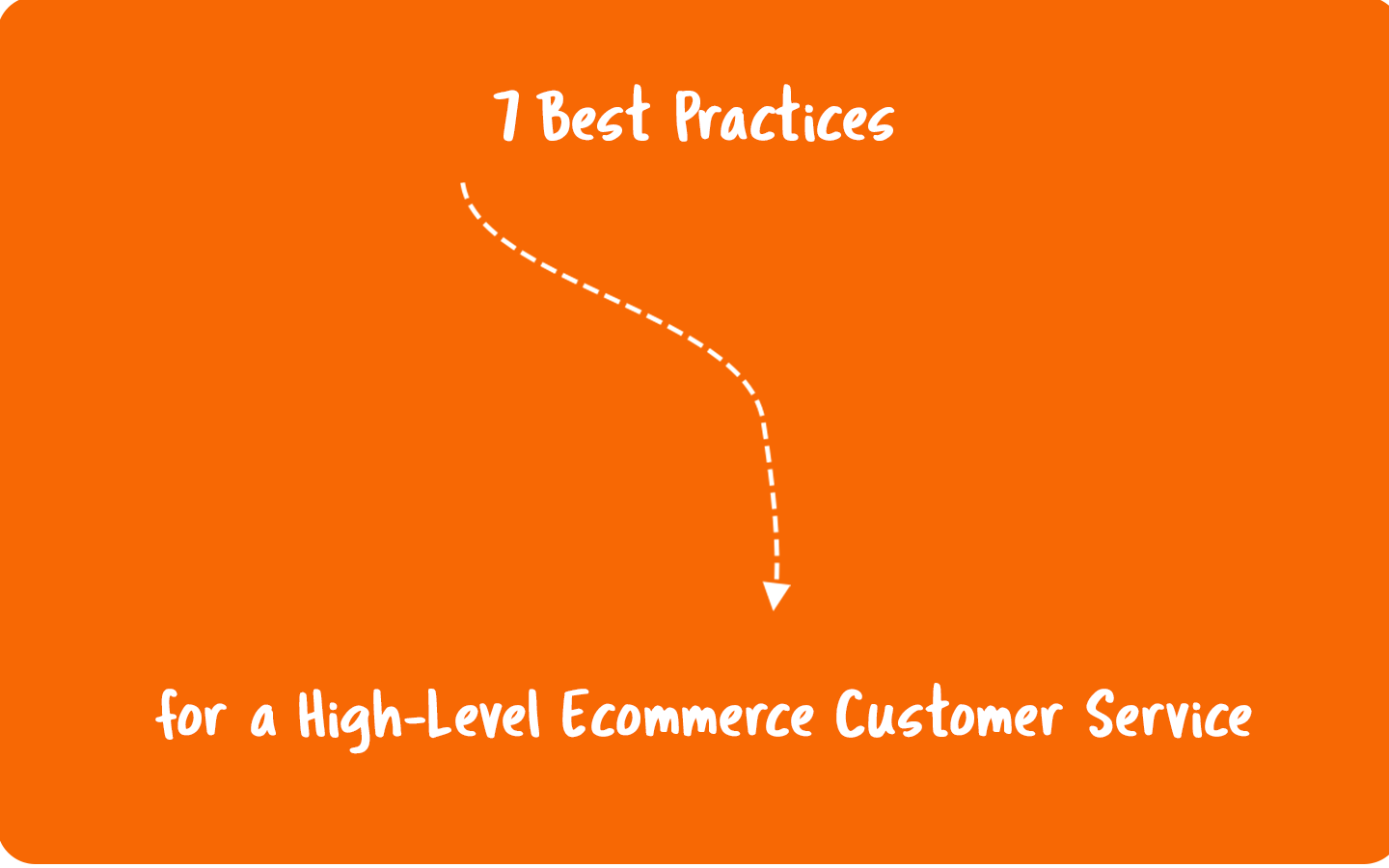
Successful eCommerce businesses know exactly how to serve their customers. Not only by providing quality products but also the best eCommerce customer service.
A Hubspot’s research reveals that 93% of customers are more inclined to repeat purchases with companies who offer excellent customer service. It shows how much it is essential to implement great strategies to support customers, delivering the best experience possible.
In this article, we will talk about 7 best practices for high-level eCommerce support that will help your brand succeed and grow like never before.
What is eCommerce customer service?
Ecommerce customer service refers to all the assistance online businesses provide to shoppers. Every time a customer has an inquire about your product/service or complaints, the customer support team needs to step up and help them get solutions.
This is actually the best way of conquering customer loyalty and even drives to sales when the support manages to reach meet customer expectations.
A 2020 report shows that after more than one bad experience with a company, around 80% of consumers say they would do business with one of their competitors instead.
That’s why there are some best practices you can follow to improve your e-commerce support.
1. Build a Multichannel support strategy
ECommerce businesses must be present in various channels to excel with marketing and generate new sales and provide customer support. The truth is that no matter where you are spreading content about your brand. You are likely to receive complaints, compliments, and suggestions there as well.
Keep an eye on all the profiles your brand has on social media channels and reviews on directories. Moreover, check out for articles mentioning your eCommerce. These usually are places where you can certainly find some potential tickets to solve.
That’s why your customer support team needs to be always aware of all the channels and prepared to answer all the requests on time. There are some key tips to build an omnichannel support strategy:
Keep the Consistency
Consistency among all the channels your company is present is a way of keeping a high-level customer service. For example, if you have a way and a specific voice while supporting customers on your website, it definitely needs to be the same on social media.
Moreover, be constant by checking all profiles periodically (every day, three times a week preferably) to avoid missing anything and keeping customers waiting.
To help you eliminate time on verifying each channel, the software monitors what people say about your brand across the web.
Avoid standard replies and be wise on public answers
Brands can make a big mistake while supporting customers on other channels, giving standard replies in public, mostly on social media comments. This is actually used a lot when companies need to manage crises and receive tons of social media complaints. In this case, it’s important to work together with the public relations team.
Otherwise, it’s better to call the customer in private to discuss what is bothering them and leave a comment signalizing this action.
Make your website “customer support friendly”
Inside your website, you can also offer multiple channels for customer service. Apart from offering a live chat, you can provide other proactive customer support features. Forms and CTA’s that lead to direct contact with the support team are great resources that can clearly show the customers where they can get help.
It’s also recommended to include customer self-service options to get answers without needing to contact the support. A good example of this kind of solution is help centers. They offer complete ways of solving issues or teaching how to do something with your product or service.
2. Answer as fast as possible
The longer the waiting, the bigger the customer’s dissatisfaction. Please don’t make them wait for a reply to the point they will open another ticket or even give up on your company.
Besides affecting how you will convert sales, the speed of closing tickets will also affect your reputation. That’s why you need to develop a thorough system of prioritizing tickets and setting due dates to solve them.
A live chat also helps to speed up ticket solving because there are issues the customers face, which can be solved instantly. Otherwise, they will fill a form, send an email, and wait 2-3 days or more for a response. And they may give up on you at some point.
3. Keep up with your customers’ journey
The support team is one of many touchpoints during a customer’s journey. That’s why they need to deliver a great experience to help the leads and clients be satisfied and continue through the pipeline.
We highly recommend that you work together with the sales team to figure out ways of helping them close sales while supporting leads at a decision-making level, for example. Also, to understand that specific customer and give them a personalized treatment, according to where they are in the sales pipeline.
Support teams must have in mind that the way they help customers will influence directly if they are going to stay and buy more from the eCommerce or leave and run to a competitor.
4. Always ask for feedback and act on them
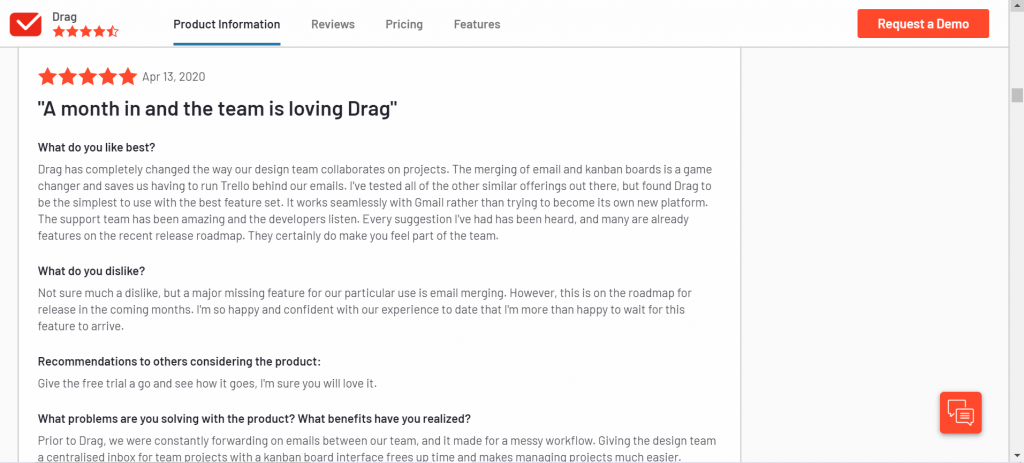
Asking for customer feedback is actually one of the A.C.A.F. Customer Feedback Loop (Ask, Categorize, Act, and Follow-up). This effective method of collecting feedback and acting on it is used to improve your brand’s customer experience.
Find the best way of collecting feedback about your business. You can ask your clients to leave reviews on directories, on your website with in-app surveys, or via email. Then categorize what you receive, for example, the pros and cons of using your product extracted from users’ opinions.
The third step of the loop is to define the best actions you can take them over. Usually, this phase requires gathering all teams in a business to discuss the possible actions.
Finally, don’t forget to follow-up the feedback with your clients, so you can motivate them always to give their opinion.
Even without asking for feedback, many times, businesses still receive may receive it. In that case, don’t forget to answer both negative and positive feedback or reviews.
5. Automate your processes with customer service tools
E-commerce customer service software, or help desks, are a must for any business. They help support teams to connect with customers and organize possible issues and information on tickets. Moreover, you can solve them easily and with as few manual steps as possible.
When you use a help desk, you can also attend to more requests than handle email and a spreadsheet. And most tools allow you to collaborate with the team to avoid a collision or even missing tickets.
Here’s a list of help desk software that can be useful to help you with this practice:
10 Best Free Help Desk Software to Make your Customer Support Thrive
6. Set metrics, create reports, and measure results

One good way of analyzing how your customer support team is performing is to set KPIs, track metrics, and generate reports. Many help desk tools offer this feature to help businesses know exactly how each agent works to support customers.
It would be best to track some essential metrics: the number of tickets, tickets closed, and period of resolution of requests.
After measuring everything you need to analyze and generate reports, you should figure out the next steps to improve the support team’s quality of work. Then implement solutions that can speed up the processes if that’s the case, train agents that need to enhance performance, etc.
7. Give your personal touch to impress your customers
When you delight your customers by creating outstanding experiences in all the stages, they pass through. They will certainly come back to purchase more or stay loyal to your brand.
It’s worth it to make an effort and develop personalized ideas for nurturing your relationship with clients while you support them. Align your brand with actions that can impress them somehow.
But just being thoughtful while supporting them can make a huge difference. Treat clients as the unique person each one of them is, and you will gain more than their trust.
Bonus: Enhancing your e-commerce customer service with a shared inbox in Gmail
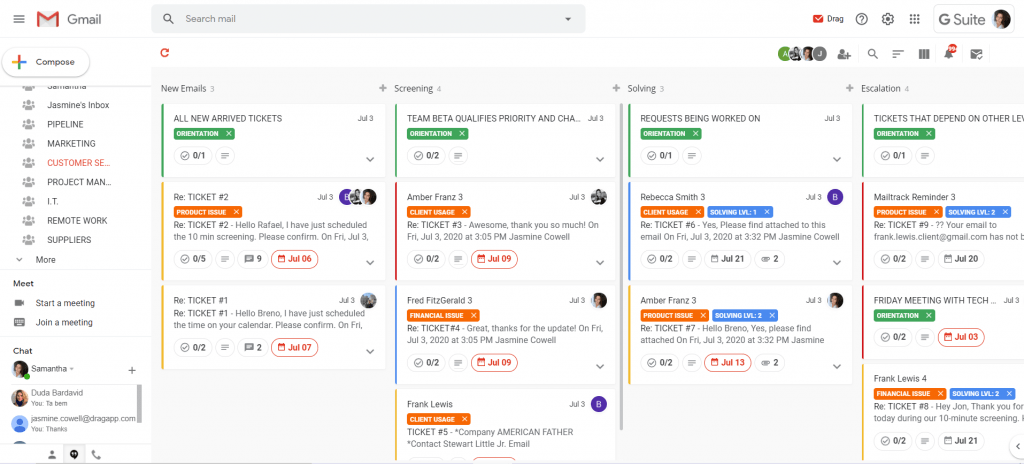
Most tickets, feedback, and other incoming requests for support arrive as emails. So we left something missing on purpose: the email customer service best practices.
Mainly because a shared inbox is definitely what your team needs to manage support emails and collaborate seamlessly. Specifically, a shared inbox inside Gmail, one of the most used platforms in the whole world.
Drag is this shared inbox we are talking about. It is built to serve many purposes, including help desk, CRM, task management, marketing, and more. Because it’s highly customizable, your whole organization can use it to manage workflows in a visual way (kanban).
Your team will visualize and interact with the email sent to support@ in a board, in their own inboxes. So you won’t need to share a Gmail account or forward emails anymore.
Let’s check how you can use Drag for eCommerce customer service in practice.
Know the context of each ticket
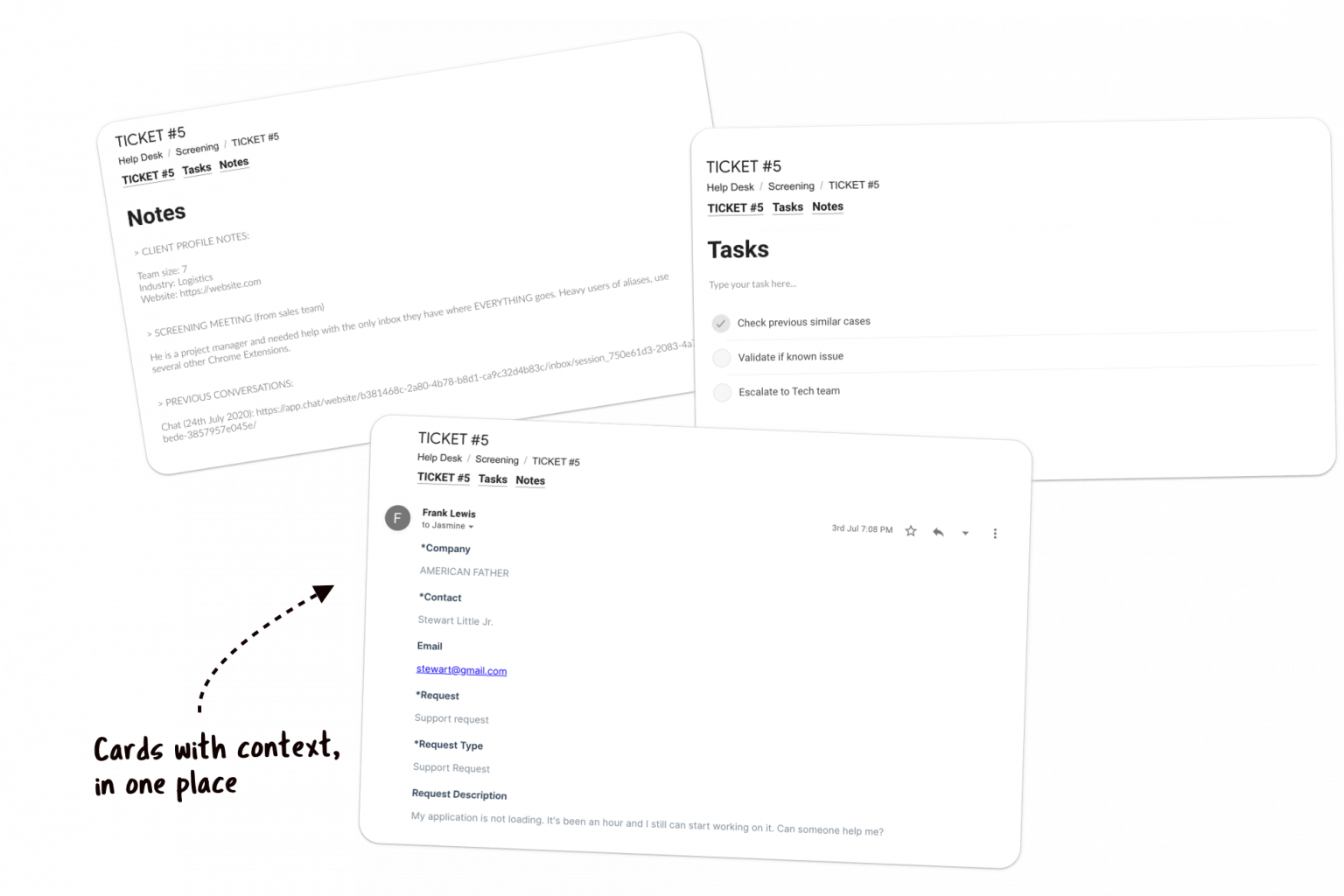
All the Drag cards allow you to have all the context you need about a ticket. Inside each card, you will see the email history, contact information, type of request, priority level, files. You will also assign emails to agents and know who is working on what because their photo will be on the card.
In the card, you will also be able to identify the due date just in a glance and know which tickets need special attention.
Collaborate with your team while supporting customers
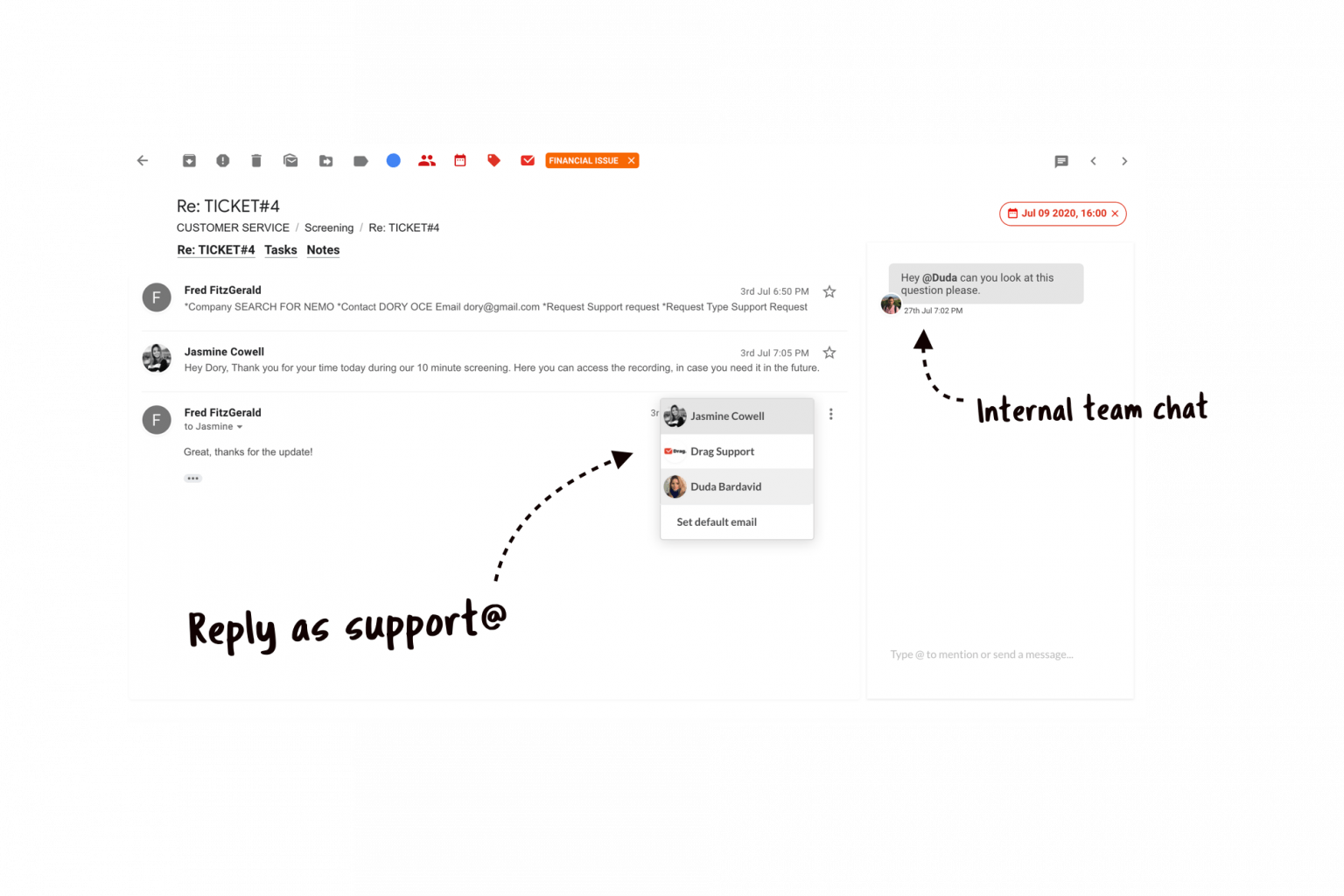
Often, support teams need to collaborate to solve issues internally or even with other teams, such as sales, finance, or development. That’s why with Drag, you have an internal team chat inside each card, where you can @mention the teammate you need help from. This gives more context to a ticket in the conversation and eliminates the back and forth to a chat tool.
It’s also possible to share email drafts, so your teammates can write emails together. And when it’s necessary to escalate a ticket and move it across teams, you can share specific boards or set cards permission levels—all of that in just one click.
Automate your support
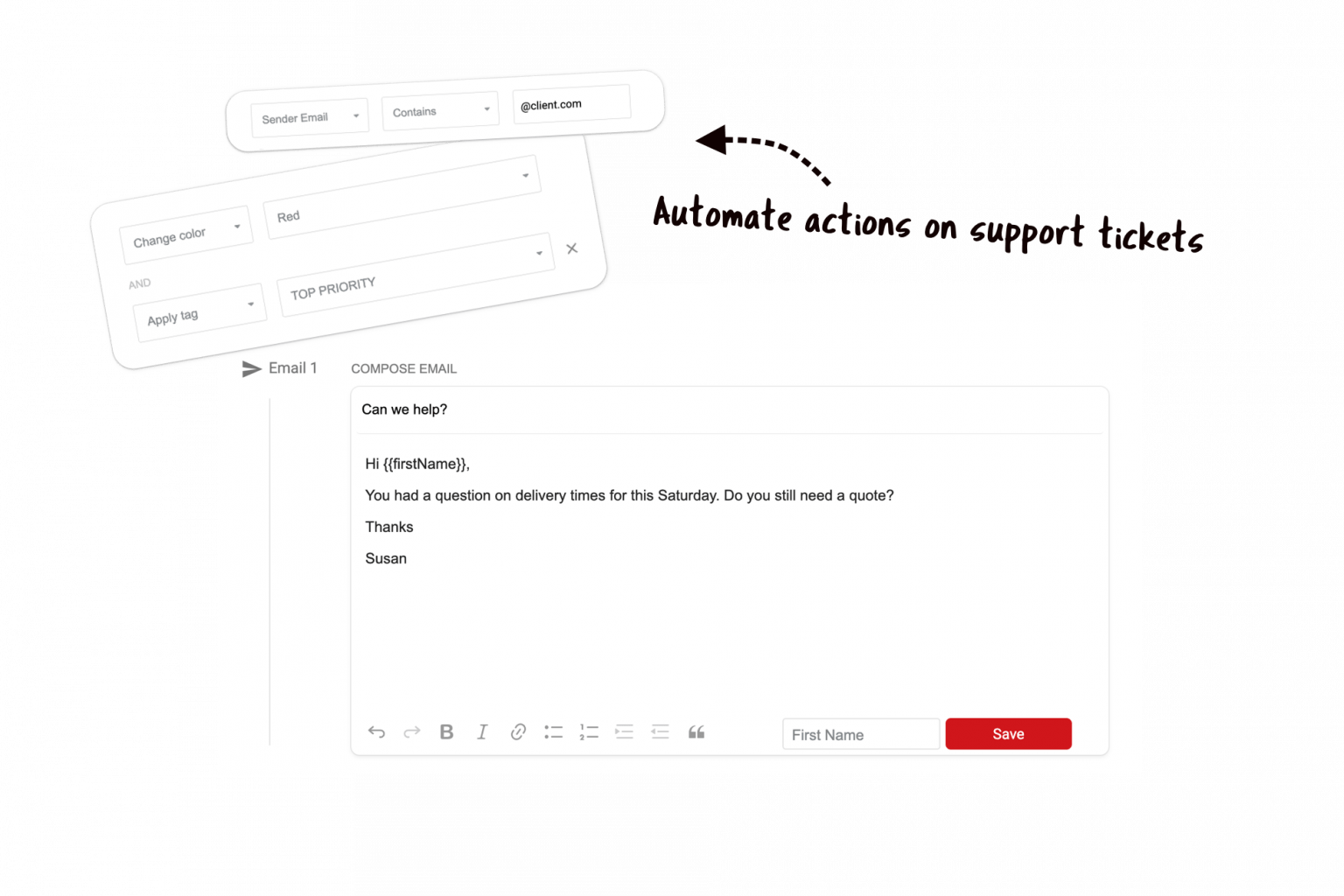
Remember when we talked about keeping consistency while supporting customers? With Drag, you can share email templates so your customer service team uses the same tone of voice and the same message aligned to your brand.
There’s also the email sequences feature that allows you to send email follow-ups to customers automatically.
You can also automate repetitive tasks (like sending an email template when moving tickets from a stage to another). You can set rules that move tickets to the right boards as they arrive so that you can focus more on the actual work than manual processes.
Never miss another deadline
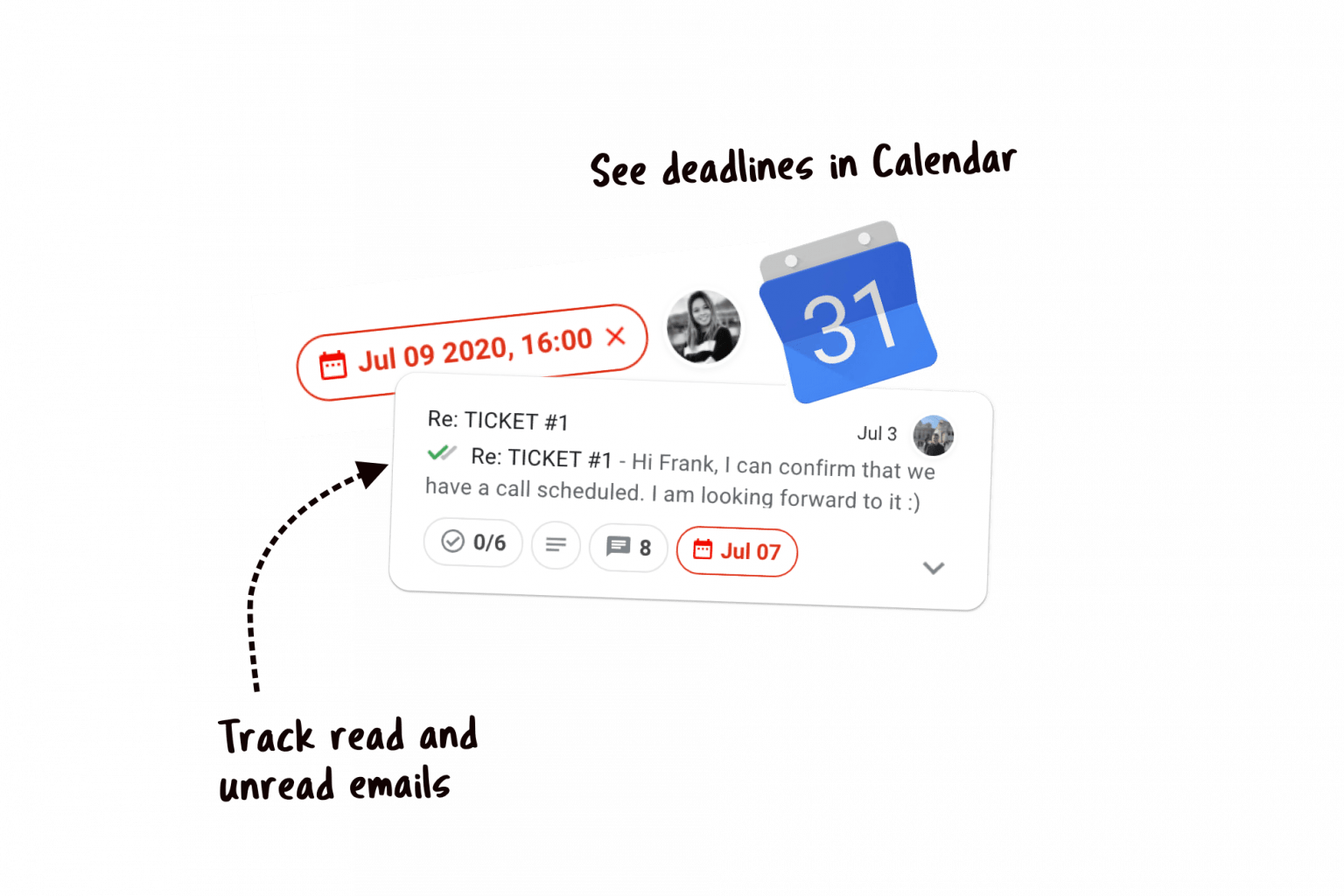
Deadlines and speed are crucial for customer service. That’s why your tickets should have due dates. Drag creates events and reminders in your agenda with Google Calendar integration when you create a due date on a card.
With Drag, you can also know when someone reads your emails, so you can know exactly what to do next.
Know how your support team is doing
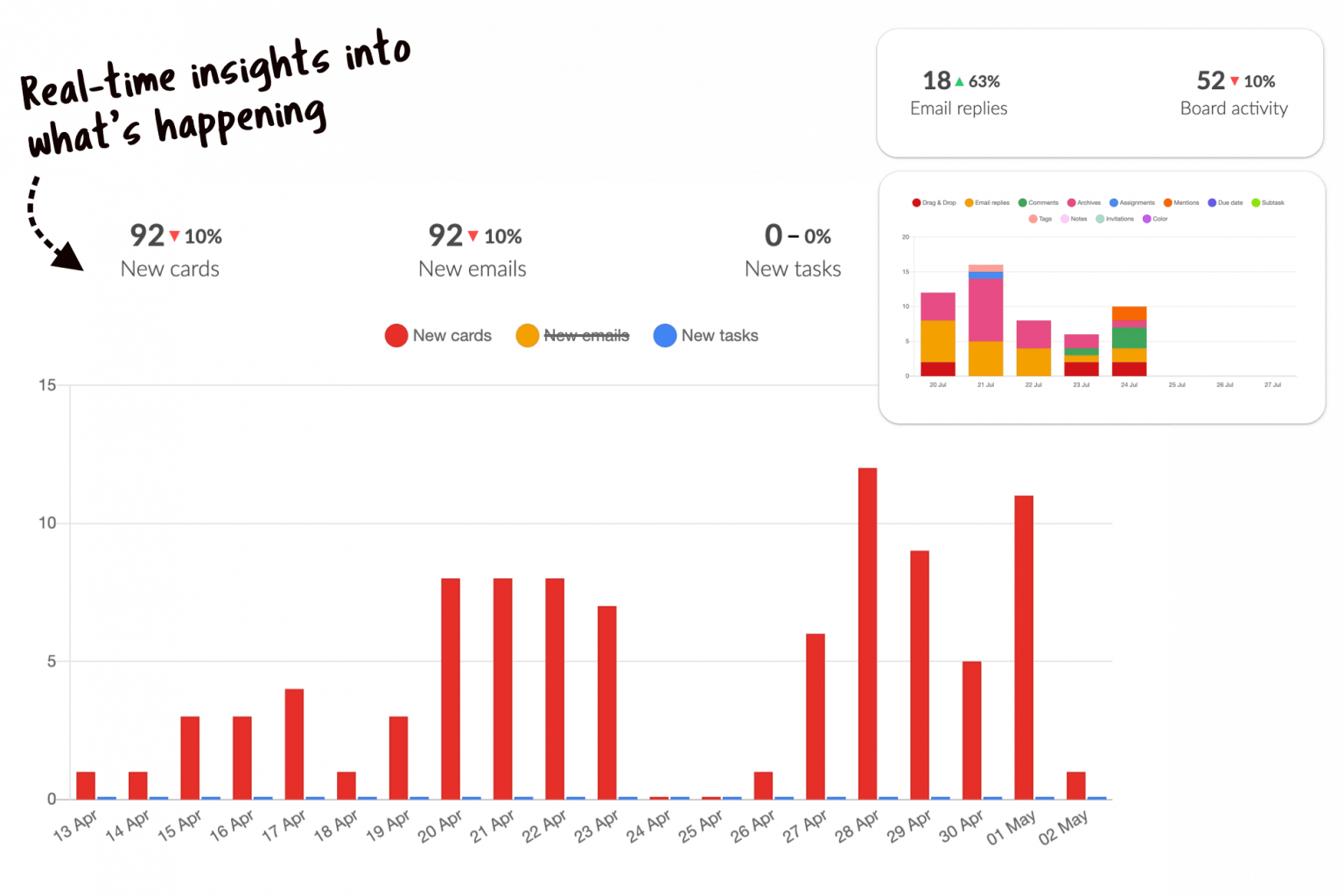 At last, you can view the performance of your customer service team at a glance. There are many different reporting for real-time insights to help you see which agents are performing the best.
At last, you can view the performance of your customer service team at a glance. There are many different reporting for real-time insights to help you see which agents are performing the best.
Drag: an eCommerce customer service case

Boosted Commerce is a Consumer Packaged Goods platform focused on accelerating the growth of consumer brands. They acquire, invest in, and grow third-party seller businesses across Amazon (FBA) and original product development across verticals.
Like other businesses, their team must deliver unmet standards in customer service and satisfaction because it impacts directly on sales and helps to expand their customer base, maintaining customer loyalty to their newly acquired businesses.
And they have a lot to manage since they need to respond to all customer inquiries within 24 hours, across 20 sales channels, and in marketplaces all over the world.
They are using Drag to build an outstanding global customer service team. For example, customers never doubt their value as each inquiry receives a timely response, and always from the “same†customer service team member.
But there’s a lot more happening with Boosted Commerce’s customer service since they decided to use Drag as a help desk software. You can read more about this use case below:
Wrapping up
Building a successful business depends a lot on how you support your customers. It will determine if they will become loyal clients or former clients that will spread bad word of mouth about your brand.
So we highly recommend that you don’t neglect this kind of relationship with clients, but invest hard in it. Train your customer success team, acquire great help desk software, and follow these best practices. You will certainly reach the next level and beyond once you master the art of offering extraordinary customer support in your eCommerce business.
Want other tips for your eCommerce business? Check these articles:
8 Best Tools for your Ecommerce you Probably Haven’t Heard Of
The Best Ecommerce CRMs (Free and Paid)
It’s time to improve your eCommerce customer service.
Drag turns Gmail into your Team’s Workspace – One single place to support customers, manage tasks and close deals, from the place teams love: Gmail. We are a Techstars-backed Company, trusted by 30,000 users around the World.







